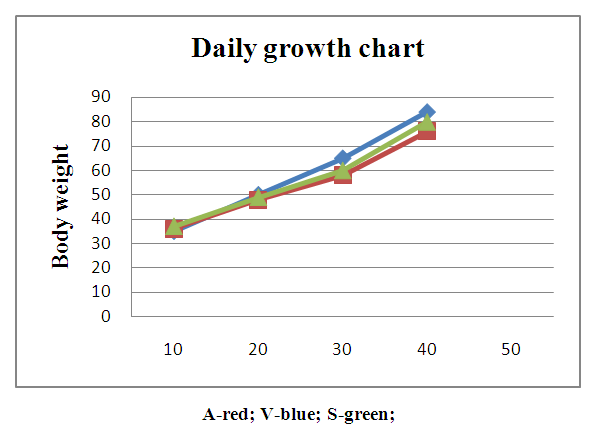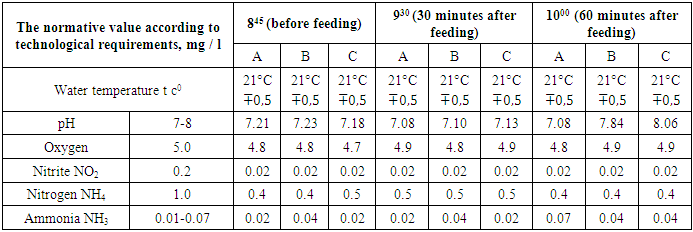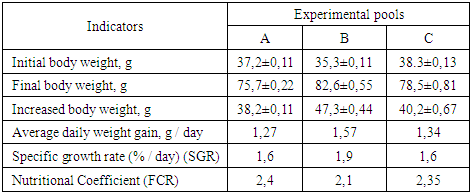-
Paper Information
- Paper Submission
-
Journal Information
- About This Journal
- Editorial Board
- Current Issue
- Archive
- Author Guidelines
- Contact Us
International Journal of Genetic Engineering
p-ISSN: 2167-7239 e-ISSN: 2167-7220
2021; 9(1): 21-23
doi:10.5923/j.ijge.20210901.04
Received: Jul. 14, 2021; Accepted: Aug. 23, 2021; Published: Aug. 31, 2021

Peculiarities of the Use of Local Microorganisms in the Feeding of Carp (Cyprinus Carpio)
Abdulla Rukhullaevich Kurbonov1, Guzal Djumaniyazovna Kutlieva2, Abdulakhmet Raymberdievich Kuzmetov3, Nilufar Tojinarovna Temirova1
1Fisheries Research Institute
2Candidate of Biological Sciences, Head of Laboratory, Institute of Microbiology, Academy of Sciences of the Republic of Uzbekistan
3Doctor of Biological Sciences, Head of the Department of “Water Bio-resources and Aquaculture”, Tashkent Regional Branch of Astrakhan State Technical University
Copyright © 2021 The Author(s). Published by Scientific & Academic Publishing.
This work is licensed under the Creative Commons Attribution International License (CC BY).
http://creativecommons.org/licenses/by/4.0/

As a result of the large-scale climatic work carried out in Uzbekistan in the middle of the XX century, the number of fish species in our water bodies increased significantly. During these periods, a number of fish species were brought from Russia, the USA, China and other countries and climate. In this article, the positive effect of adding “BACTOVIT UZ” bio-preparation to carp food in closed circulation water supply devices of “Technologies in Aquaculture of the Fisheries Research Institute” of the Research Institute of Fisheries is reflected in the experiments. Depending on the growth of the fish, a daily ration is developed.
Keywords: “BACTOVIT UZ”, Bio-preparation, Mixed feed, Hydrobionts, Microorganism, Probiotic, Fish
Cite this paper: Abdulla Rukhullaevich Kurbonov, Guzal Djumaniyazovna Kutlieva, Abdulakhmet Raymberdievich Kuzmetov, Nilufar Tojinarovna Temirova, Peculiarities of the Use of Local Microorganisms in the Feeding of Carp (Cyprinus Carpio), International Journal of Genetic Engineering, Vol. 9 No. 1, 2021, pp. 21-23. doi: 10.5923/j.ijge.20210901.04.
Article Outline
1. Introduction
- In Uzbekistan, the cultivation of Fish and obtaining quality products from fish depends mainly on the diet. It is natural that the growing cost of food will come out of economic circulation. Therefore, there is a need for the production of technologies of intensive feed production, which will make a significant contribution to the economy of the Republic. The use of natural nutrients for fish: zooplankton, phytoplankton, benthos and macro-phytes in addition to feed is used in world practice. The climate of our country is very favorable for the cultivation of all types of agricultural products. In recent years, Technologies for intensive use of water bodies have been developed. The development and implementation of technologies for the use of all components in water bodies for fish is of paramount importance. Therefore, savings in natural feed are expected to increase by 20-30% and fish viability by 50%. Provision of artificial cultivation of natural nutrients can be carried out on feminine farms, greenhouses, stagnant water basins. Therefore, it is necessary to form a single base on the current Republic. These organisms are considered to be low-cost, as well as rich in biologically active substances in comparison with feed and other nutrients.
2. The Main Findings and Results
- The main scientific works of many scientists in Uzbekistan on the natural nutrition of fish, including: Doctor of Biological Sciences, Professor I.M. Mirabdullaev, Doctor of Biological Sciences, Professor A.R. Kuzmetov, Doctor of Philosophy in Biological Sciences H.H. Abdinazarov and others dedicated to benthos and macrophytes. This issue is also on the agenda abroad.The productivity of fish raised in fishery basins is directly related to all living components in the basin. All aquatic aquatic organisms play an important role as fish feed.Fish differ in nutrition from other vertebrates. Almost all of the fish grown in Uzbekistan are fed by zooplankton organisms during the creeping period. From herbivorous fish, white Hawthorn passes when feeding with phytoplankton reaches a length of 1,5 cm. To some extent zooplankton organisms also want it during this period. White Amur fish 3-4 cm and at the age of one year go to the feeding with water plants. White Amur is fed only by high plants that grow in water and young plants that grow on earth.The application of the bio-preperate “BACTOVIT UZ”, presented by the Institute of Microbiology, in experiments on the addition of nutrients to fish is determined. Bio-preparate “BACTOVIT UZ” has the property of improving the digestion of mainly poultry and fish, preventing and treating various intestinal diseases. It is a drug created on the basis of local microorganisms, is a probiotic, fermented and protein-rich feed additive. It also serves to increase the energy value, efficiency, productivity of nitrogen.
3. Research Materials and Methods
- The research was conducted for 45 days in the closed circulating water supply facilities of the “Laboratory of New Technologies in Aquaculture” of the Fisheries Research Institute. In the experiment, local carp (Cyprinus carpio) fish were used. The fish were raised in pools with a volume of 2m3.Each pool was filled with 150 fish fry with an average weight of 35-40 g. Experiments: Controlled fish in pool A, dry matter of “BACTOVIT UZ” bio-preperate in pool V (5% of 1 kg of mixed feed), suspension of “BACTOVIT UZ” bio-preperate in S-pool (5% of 1 kg of mixed feed) experiments were performed without. The composition of the mixed feed in the experiment was prepared according to Table 1.
|
4. Obtained Results
- Nutrition was given in 900, 1200, 1600, as well as in 2000, when the daily ration was divided into 4 parts. Developed a daily ration depending on the growth of the fish, conducted control hunting in every 15 days. Experimental fish were brought from the soil pools of the Institute. In order for the difference in water temperature to not be sharp and prevent fish disease, the water temperature rose gradually for 5 days and the fish were adapted to the swimming pools. No fish were killed in any of the pools during the experiment. The water temperature averaged 210S∓0.5 during the experiment, and the hydro-chemical parameters of the water are as follows (Table 2).
|
|
 | Diagram 1 |
5. Conclusions
- In conclusion, the use of BACTOVIT UZ in the preparation of high-quality feed for fish has been shown in experiments to be effective, as well as to increase the efficiency of feed consumption.At the same time, it is recommended to conduct a series of studies on the level and cost-effectiveness of adding this feed supplement to the mixed feed, depending on the age and type of fish.
 Abstract
Abstract Reference
Reference Full-Text PDF
Full-Text PDF Full-text HTML
Full-text HTML

